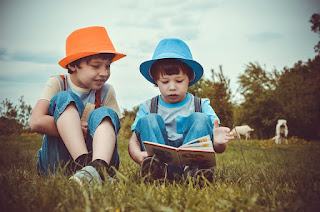 |
| Image by Victoria_Regen from Pixabay |
First of all, when it comes to choosing literature for young kids, it's important to consider their age and reading level. When it comes to choosing literature for young kids, there are several factors to consider, including age-appropriateness, educational value, engaging content, and diverse perspectives. For very young children, picture books with simple stories and bright, engaging illustrations are a great choice. As they get older and begin to read on their own, early chapter books with short chapters and larger font sizes can help build their confidence and love for reading.
But what about the content of the books themselves? This is where things can get a little tricky. On the one hand, we want to expose young readers to a diverse range of stories and perspectives. On the other hand, we also want to make sure that the content is appropriate for their age and level of understanding.
One approach is to look for books that tackle important issues in a way that is accessible and relatable for young readers. For example, books like "Last Stop on Market Street" by Matt de la Peña and "The Day You Begin" by Jacqueline Woodson address issues of diversity and inclusion in a way that is both entertaining and educational.
At the same time, we also want to make sure that kids are exposed to a range of genres and styles of writing. This means introducing them to classics like "Charlotte's Web" by E.B. White and "The Lion, the Witch, and the Wardrobe" by C.S. Lewis, as well as more modern works like "Diary of a Wimpy Kid" by Jeff Kinney and "Harry Potter" by J.K. Rowling.
Here are some popular choices of literature that are often considered among the best for young kids, along with a world perspective:
"The Very Hungry Caterpillar" by Eric Carle: This classic picture book introduces children to numbers, colors, and the life cycle of a butterfly. It is beloved worldwide and has been translated into numerous languages, making it accessible to children from different cultures.
"Goodnight Moon" by Margaret Wise Brown: This soothing bedtime story is known for its simple, rhythmic text and calming illustrations. It promotes a sense of comfort and routine, which is universal across cultures.
"Where the Wild Things Are" by Maurice Sendak: This imaginative tale follows a young boy named Max as he embarks on a wild adventure in a magical land. It encourages creativity and self-expression, which are valued in various cultures.
"The Lion and the Mouse" by Jerry Pinkney and Gerald Rose : This wordless picture book retells the classic Aesop's fable with stunning illustrations. It teaches children about the value of kindness and cooperation, promoting empathy and understanding across cultures.
"The Snowy Day" by Ezra Jack Keats: This groundbreaking book features a young African-American boy named Peter exploring the wonders of a snowy day. It is recognized for its representation of diversity and has had a significant impact on children's literature worldwide.
"Oh, the Places You'll Go!" by Dr. Seuss: This whimsical and inspirational book encourages children to embrace life's adventures and persevere through challenges. Its uplifting message transcends cultural boundaries and resonates with young readers globally.
"The Diary of a Wimpy Kid" series by Jeff Kinney: These humorous and relatable books follow the misadventures of Greg Heffley, appealing to older children and reluctant readers. The series has gained popularity worldwide, providing a light-hearted perspective on the challenges of growing up.
It's important to note that the best choices of literature for young kids can vary depending on their individual interests, cultural backgrounds, and reading abilities. It's recommended to expose children to a wide range of books that reflect diverse cultures, experiences, and perspectives, fostering a love for reading and a deeper understanding of the world around them.
Of course, this is all just my opinion. Everyone has their own preferences when it comes to children's literature, and what works for one child may not work for another. But I believe that by exposing young readers to a diverse range of stories and perspectives, we can help them develop empathy, curiosity, and a lifelong love for reading.
So, what do you think? Do you agree with my choices of literature for young kids? What are some of your favorite books? Let me know in the comments below!

Comments
Post a Comment
Drop any query, suggestion or comment here.